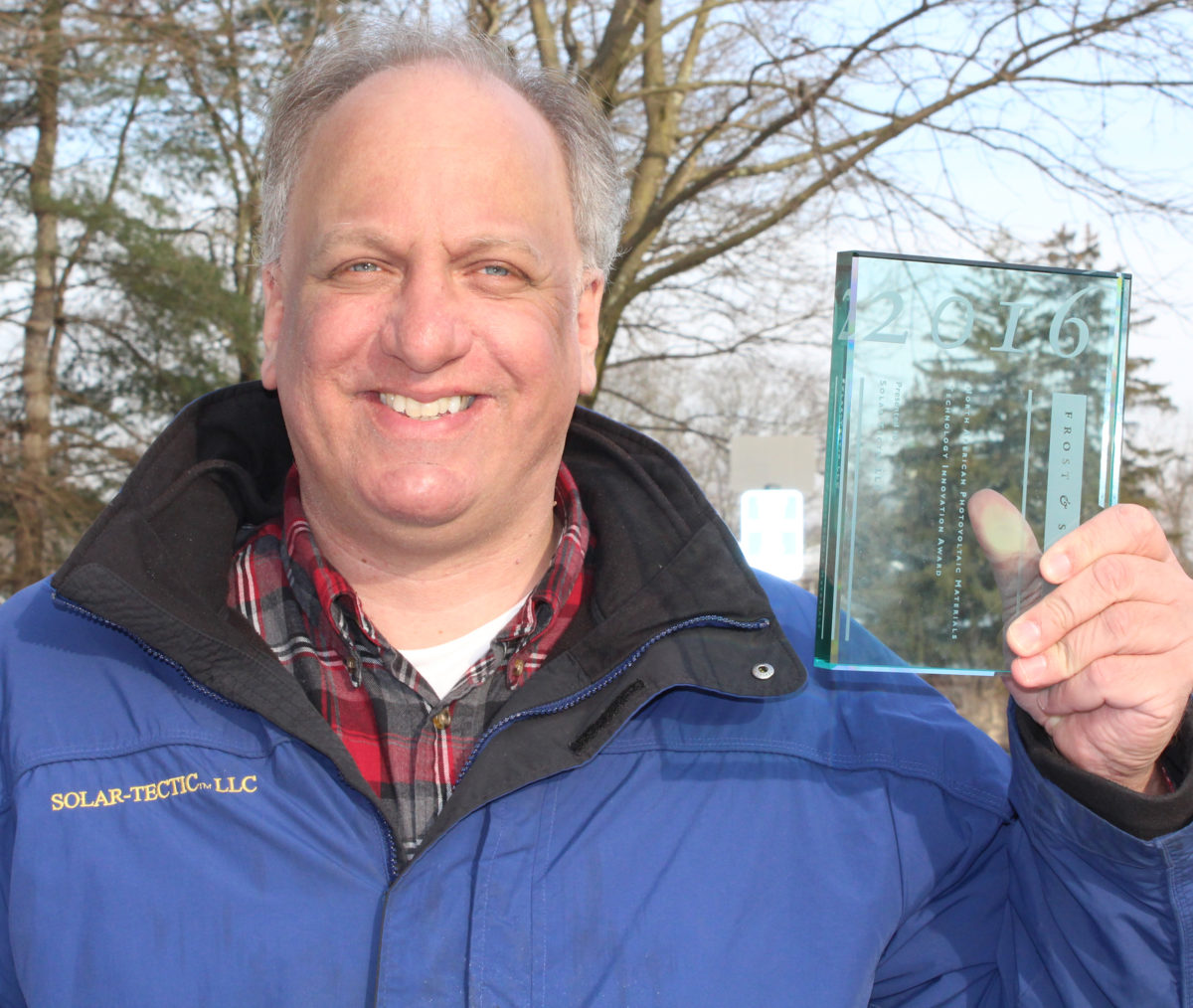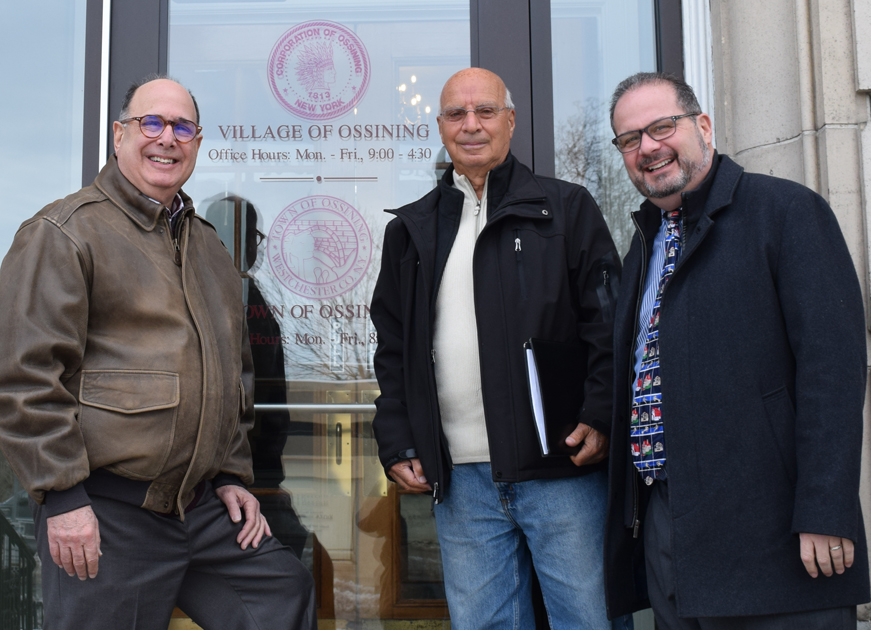AÂ Briarcliff Manor entrepreneur is trying to create the world”™s most efficient and commercially viable solar cell, building on his late father”™s scientific legacy and perhaps helping to change an entire industry.
Ashok Chaudhari heads Solar-Tectic LLC, a solar research and development firm that its founder describes as a family company that includes his mother and sister.
From a home office in Briarcliff, Solar-Tectic has been awarded five patents in different solar technologies, most recently for a germanium perovskite thin film tandem solar cell. The company has an additional 20 patents pending.Â

Its most recent patent, granted by the U.S. Patent and Trademark Office in January, is the latest step for the company in creating a tandem thin film solar cell. It”™s a type of cell that Chaudhari believes will prove more efficient and cheaper to produce than the currently dominant silicon wafer cell, used in about of 90 percent of solar panels.Â
Chaudhari has developed a small solar cell from a previous patent as a proof of concept, but the majority of his work to this point is in intellectual property, developing patents.
No solar panel now on the commercial market can reach 30 percent efficiency at converting light into energy, but Chaudhari believes Solar-Tectic”™s cell design can do that. And if a cell can reach that high efficiency, solar has the ability to grow from a still small share of U.S. energy production into a primary source, he said.
“At 30 percent, at these costs, fossil fuels for electricity generation would no longer be necessary,” he said.
The story of how Chaudhari, who once planned to become a minister, came to lead his own scientific research firm starts with the legacy of his father, a renowned materials physicist.
PRAVEEN CHAUDHARI
Praveen Chaudhari, a native of India who arrived in the U.S. in 1961 as a graduate student in physical metallurgy at MIT, held various research and management positions for three decades at IBM, including a stint as vice president of science for the Armonk-based company. Under his stewardship, IBM scientists were awarded two Nobel Prizes.
Chaudhari applied for 22 patents while at IBM, including one for the erasable read-write compact discs often used to burn music or other data files. In 1995, President Bill Clinton awarded him the National Medal of Technology and Innovation for the invention, recognizing that the technology served as the foundation for the magnetic-optic disk industry.
In 2003, he was appointed by President George W. Bush as director of the Brookhaven National Laboratory, the Long Island institute run by the federal Department of Energy. Chaudhari served in the role until 2006.
He died in 2010, two years after filing for his final patent: a method for growing heterepitaxial single crystal or large-grained semiconductor films and devices. The patent provides a method for producing a thin film of an inexpensive semiconductor, such as silicon, at a low temperature, and depositing the film on an inexpensive surface, such as glass.
That patent was finally granted in 2015, but had already laid the groundwork for the technology Solar-Tectic is developing today.
Ashok Chaudhari may seem an unlikely heir to carry on his father”™s invention.
The entrepreneur, who holds a master”™s degree in religious studies from Stanford University and a master of divinity degree from Union Theological Seminary in Manhattan, said he was in the process of being ordained as a Presbyterian minister when the elder Chaudhari died and he was drawn to his father”™s work researching solar technology.
Chaudhari said his father likely took on the solar research project as the latest in a series of engineering challenges, yet he also wanted to write the patent for his family. He and his father had discussed the possibility that Ashok would continue the solar cell research, but he said neither of them expected it would lead to a long-term project.
“I didn”™t see myself as someone starting a solar company. I was going to be a minister at that time,” Chaudhari said. “I thought, OK, it”™s great he wrote this patent for the family and if I can develop it or bring it further, I”™ll do it, but I was thinking maybe it was a part-time thing or a weekend hobby. I didn”™t expect to be spending full-time on the business.”
He first tried to license the technology to another company for development. When that didn”™t work out, he launched Solar-Tectic as a way to try to finish and commercialize the solar technology his father left behind.
“I didn”™t know a thing,” he said. “But right away, it really grabbed me.”
He landed at SUNY Polytechnic Institute”™s iClean incubator for energy and nanotechnology in Albany, where for a year his company had access to expensive equipment and expertise. Solar-Tectic has also worked with the National Renewable Energy Laboratory in Colorado and Blue Wave Semiconductors, a Maryland-based manufacturer, to build a prototype of an earlier patent.
After almost seven years in research and development, Solar-Tectic now has patents either approved or pending for technology Chaudhari believes can boost solar cell efficiency.
THEÂ TECHNOLOGY
The U.S. solar market is already growing rapidly. Solar installations increased by 95 percent in 2016 over a number in 2015 that was already a record, according to data from the Solar Energy Industries Association.
That growth has been spurred in part by a reduction in the cost of solar energy production. Chaudhari said the prices can be driven down even more by advances in solar cell technology.Â
The dominant silicon wafer solar cells convert light into energy with an efficiency that averages about 18 percent. The race is on to create a solar cell that can surpass that efficiency without increasing production costs.Â
Solar-Tectic”™s research has produced what Chaudhari says is a viable solution. It uses thin film to produce a tandem solar cell. Thin film is a less commonly used type of solar cell that deposits one or more ultra-thin layers of photovoltaic material on glass. The tandem thin film cell would use two separate photovoltaic materials in the film to capture a wider range of wavelengths on the light spectrum, increasing efficiency. “The best of both worlds,” Chaudhari described it.
The company”™s most recent patent, for a germanium perovskite thin film tandem solar cell, is its most significant yet, according to Chaudhari. He said it”™s the first patent for a tandem structure thin film cell. Thin film uses less material and can be produced at a lower temperature, potentially lowering the costs to make it.
Solar-Tectic also has a patent pending for a silicon perovskite thin film tandem cell, along with a variety of other materials. The material combinations change slightly with each patent, but the focus is consistent on creating a tandem thin film cell with a different material on a bottom layer and top layer.
Chaudhari said the recently patented solar cell is especially promising because germanium is more efficient at converting light into electricity than silicon. But the material is so expensive that it”™s now used only in satellites, he said. By using it in thin film, where the material needed is a fraction of the width of a strand of hair, it could become affordable enough to be commercially viable, he said.
The materials would be grown on a soda-lime glass surface, the same glass used on window panes and to bottle soda, another way to keep production costs down.
The company in 2016 began to shift its focus from researching and developing intellectual property to publicizing its results. Last July, Chaudhari published a paper in the U.K.-based “Journal of Energy Challenges and Mechanics.” Solar-Tectic”™s research was recognized with a national award in January by the Texas-based market research firm Frost & Sullivan.
Chaudhari said the company is seeking funding to finance a proof-of-concept for its tandem thin film technology. He is also in talks with companies on a potential partnership to develop and commercialize the patented technology.
The goal is an ambitious one, but Chaudhari is confident his company”™s solar cell technology can create the world”™s most efficient solar cell.
“We have the technology and we have the patents for it,” he said. “The world”™s most efficient solar cell, but also cost-effective. We are not going to give up the cost factor.”



















Wow! Impressive solar technology. If his solar cell can produce 30% efficiency, it will be a game changer. It sounds like the cost will be low enough for the average home owner to use. Elon Musk has created a solar roof tile https://www.boldsolarsolutions.com/the-secret-of-new-tesla-solar-panel-glass-tile/
Regards,
Tim
Exciting, to say the least!